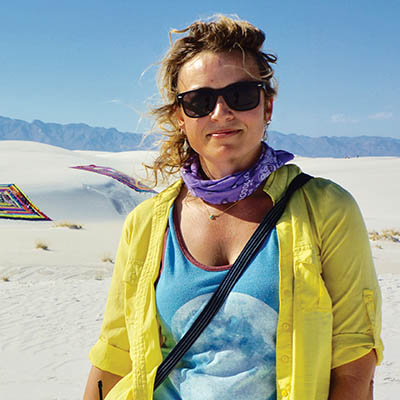Ta-Da!
Rachel Hayes’s work is huge, colorful, tough, delicate, and feminist
“Angela’s Sky,” 1 of 7 panels by Rachel Hayes, various fabrics
When you stand in the alley north of the Archer Building and face south, you see a nondescript row of identical garage doors lining the concrete walkway outside the Tulsa Artist Fellowship Refinery.
When you stand at artist Rachel Hayes’s garage door to be let in, a mechanical hum cranks it up one foot, then two, then three. What you then see is an eyeful of heaven—a multi-story, multi-colored blanket, a playground parachute, a gigantic magician’s handkerchief, a wall of shifting light. It looks like the makings of your childhood tent of dreams, and is big enough to knock you back a step.
“It’s tent material, exactly, like a tarp! And this one, the wholesaler told me it’s princess dress material,” Hayes said, pointing with a smile to each strip of fabric that makes up one of several gigantic panels in a new work in progress. She’s a woman of 40, a mother of two young children, in frayed-hem jeans and a black button-down shirt festooned with white swans. She’s pieced these four-inch strips together one by one, in a pattern that’s a riff on an old log cabin quilt design.
“Light, dark, light, dark, opaque, translucent,” she said, running a finger across the panel. It’s almost like a chant. “Sometimes it’s hard to tell what I’m doing because the piece is getting so big. It’s like a game. I don’t plan it beforehand.”
Hayes was organizing her studio the day I visited, cleaning up after a whirlwind trip to Italy, where her work floated above a fashion show runway celebrating Angela Missoni’s 20 years at her company’s helm. Missoni found Hayes on Instagram, by way of a photo Hayes posted of one of her pieces in the empty field out by Cain’s Ballroom.
After the show, Missoni invited her to collaborate on an ad campaign that featured some of her work in White Sands National Park. (She’s having to learn about licensing her art for commercial use, a process she described as “sticky.”) Facebook headquarters recently acquired one of her pieces. She’s got installations going up in February 2018 at 108 Contemporary and in Philbrook Museum of Art’s rotunda, in March at the University of Maryland, and later in the year on the Carl Sterner Arts Trail in Pennsylvania. It’s her first year as a Tulsa Artist Fellow, though she’s lived in Tulsa since 2016, when her husband, painter Eric Sall, joined the inaugural class of the fellowship program.
 “I feel like I’m tapping into something, finally,” Hayes laughed.
“I feel like I’m tapping into something, finally,” Hayes laughed.
Like much of the textile art traditionally considered to be women’s work, from which she draws inspiration in both form and process, Hayes’s work holds complexity with ease. It’s visually powerful, striking in scale, and tough enough to hang in the elements. It’s also comforting and delicate and personal—hand-cut, wobbly-stitched, laboriously pieced, using materials from tulle to theater-lighting gels. Her spectacular Missoni panels live, nestled in soft bundles, in an Ikea tote.
“I loved working big in the beginning because I just wanted to take up space,” she said. “You have this intimate experience with the tiny stitches, but you also have a big ta-da when it’s all unfurled.”
Hayes grew up in Kansas City in a family of musicians and artisans. She studied sculpture at the Kansas City Art Institute, but something about it irked her.
“There were 20 people in this stone carving class and only two girls. I was detecting something I didn’t really want to be challenged with,” she said. “I was attracted to sewing because it was a way for me to build something big and I could fold it up, kind of like a quilt, and then have the surprise of this huge physical object.
“There’s been a lot of feminist manifesto secretly going on while I’m sewing,” she continued. “Sewing comes with its own meaning. These stitches really did come through the lineage of women’s work. I keep reusing pieces so they don’t just have one life. I love to voice those things more now.”
Quilts, tents, prayer flags. Color, movement, light. Hayes holds many layers all at once. The meaning’s in the pieces, one by one.
“When I was making my first piece out of light gels in 2015,” she recalled, “I wanted to give the work more meaning. To say something. Eventually I just decided I was going to try to make something beautiful. Like a gift.”


.jpg)
.jpg)
